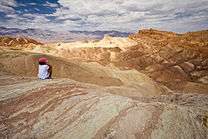Amargosa Chaos
| Amargosa Chaos | |
|---|---|
|
Manly Beacon and Red Cathedral viewed from Zabriskie Point | |
| Type | Geological formation |
| Location | |
| Region | Death Valley |
| Country | United States |
| Type section | |
| Named by | Levi F. Noble |
The Amargosa Chaos is a series of geological formations located in the Black Mountains in southern Death Valley. In the 1930s, geologist Levi F. Noble studied the faulting and folding in the area, dubbing it the "Amargosa chaos" due to the extreme warping of the rock. Later researchers discovered that the region had experienced substantial tension that pulled large blocks of crust apart.
Modern geologists have documented four major deformational events that faulted and folded the Amargosa Chaos. The first event metamorphosed Death Valley's Precambrian basement rocks and occurred around 1,700 million years ago.
The second event began while layered younger Precambrian sediments were being deposited on top of the beveled surface of older metamorphic basement rocks. This deformational event shifted the crust vertically, creating thinning and thickening of some sedimentary layers as they were being deposited.
The two events responsible for the chaotic appearance of the Amargosa Chaos did not occur until over half a billion years later, during Mesozoic or Early Tertiary time. This third event folded the layered Precambrian and Cambrian sedimentary rocks.
The fourth and final event occurred quite recently, geologically speaking. This phase of deformation coincided with severe crustal stretching that created the deep valleys and high mountains of this part of the Basin and Range Province. In just a few million years, during Late Miocene to Pliocene time, older rocks were intensely faulted and sheared. In some areas all that remains of some thick rock layers are lens-shaped pods of rock bounded on all sides by faults. Other layers have been sliced out of their original sequence altogether.
